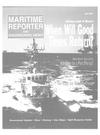
Page 54: of Maritime Reporter Magazine (April 2004)
Offshore Technology Yearbook
Read this page in Pdf, Flash or Html5 edition of April 2004 Maritime Reporter Magazine
These oil producing fields in the North Sea served by Teekay's shuttle tankers, which bring the most of the cargoes ashore to terminals and refineries in North West Europe. Some volumes are also transported to the Mediterranian and to
Teekay's shuttle tanker Navion Britannia was built in Spain in 1998. This DP II vessel loads 860 000 barrels of crude oil.
Expanding the Suezmax fleet and greater involvement in carrying oil products are among the ambitions being pur- sued by theTeekay Tanker Services (TTS) business unit of
Teekay. "At the same time, we're working to expand our strong Aframax position," said TTS Vice President Peder
Farmen. who heads the product transport sector of TTS from the group's Norwegian office in Stavanger.
Teekay's conventional shipping operations in Norway have further diversified the company's fleet, the majority of which is comprised of Aframax vessels. Since Teekay's acquisitions of Bona Shipholding in 1999, Ugland Nordic
Shipping in 2001 and Navion in 2002, Teekay has estab- lished itself as a leading tanker operator in the North Sea and Atlantic, in addition to the Pacific. The group now owns and operates a fleet of approximately 100 conventional tankers and has chartering offices in Connecticut. Houston.
London, Singapore, Stavanger and Tokyo.
Teekay's conventional shipping business in Stavanger derives from Navion, which was established in the late 1970s as a support function for the growing crude sales of the Norwegian oil company, Statoil. Over two decades,
Navion developed into one of Norway's largest shipping companies. Its main markets were in the North Sea and the
Atlantic basin. While TTS is led from Vancouver. Canada, approximately 30 staff at the Stavanger office are involved in the business development, chartering and post fixture operations together with a team in London.
Most of the conventional tankers operated by Teekay from
Norway are chartered from shipowning companies - some for periods as long as 10 years. The fleet comprises 32 dou- ble hull ships with an average age of less than four years.
The main traffic areas are northwestern Europe and the
North Atlantic, but Mediterranean and West African desti- nations are also served.
NORSEIight Adds Wipers
NORSElight extended its product line with a new heavy duty straightline window wiper system. The new wiper sys- tem has customized features, such as overlapping blades and tailor-made control panels for groups or separate wiper units. The wiper system is suitable for use on larger vessels or applications with large windows, and is particularly suit- ed for vessels that operate at high speeds. The fully sealed, water-tight motor is integrated into the wiper house is an integral part of the complete assembly. Wiper length is from 50 - 500cm. Blades and arms use stainless steel materi- als that have a matte brown finish to prevent glare. The blades are articulated type suitable for curved or flat glass.
Circle 47on Reader Service Card
Tanker approach
SMT: Safe and Cost
Effective Mooring
Tandem offloading from a spread moored FPSO is a high-risk operation that involves significant challenges with respect to safety and regularity.
Based on extensive operational experience with shuttle tankers, combined with state-of-the art knowledge on mooring systems, APL has in co- operation with Statoil developed SMT, a concept designed to improve safety and regularity.
The SMT system improves tandem operations and seeks to dramatically reduce risk. The basics of the concept is to utilize the mooring lines of the FPSO to introduce a collision barrier between tanker and FPSO and to prevent the tanker from extensive rotation in case of a change in weather direction or abnormal opera- tion. The aft most mooring lines of the FPSO, or two dedicated mooring lines, are routed in an appropriate direction. At a distance of 100m to 150m from the FPSO two mooring buoys are connected to the FPSO mooring lines. The for- ward mooring lines of the export tanker is con- nected to these buoys. Between the buoys a col- lision barrier, consisting of heavy-duty fenders, is
Restricted tanker movement by tenders. arranged. At a distance of approximately 700m from the FPSO a second set of buoys are con- nected to the mooring lines. The aft mooring lines of the export tanker are further connected to these buoys. The loading hose (floating hose string) is routed from the manifold on the FPSO to one of the mooring buoys, and further to the midship manifold of the export tanker. A rigid spool pipe is arranged on the mooring buoy with a flange connection to the loading hoses. In idle condition the outer loading hose can be tied back to the FPSO to avoid entanglement and obstruction during tanker berthing.
The berthing operation will be similar to a stan- dard SPM berthing. During approach a tug with sufficient bollard pull will be attached to the stern of the tanker for safeguard. The collision barrier will be a second safeguard for avoiding collision with the FPSO. When the tanker is in position the assistance vessel will hand over the fwd mooring lines, which will be pulled in and locked in the chain stoppers. The aft mooring lines will then be picked up by the assistance vessel, handed over to the tanker and attached to the strong points aft. Finally the loading hoses are tugged over to the tanker and connected to the midship manifold.
Circle 48 on Reader Service Card
Tanker moored to FPSO -*• „ - -i i-• f 1 i 50 Maritime Reporter & Engineering News

 53
53

 55
55
